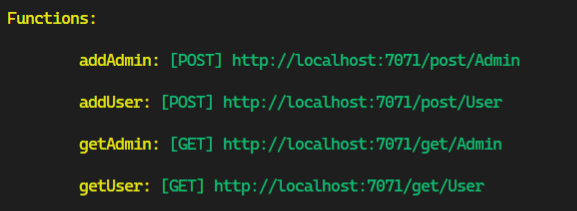When you initialise a new HTTP trigger function using the Azure Functions CLI, you are prompted for the name for your function. This name is used for the folder within your project but also the name of the function itself. There are also some default configuration settings for the URI that will be used when you publish your FunctionApp.
Route Prefixes
When you create Azure Functions project which has HTTP endpoints all function routes by default are prefixed with api e.g. myFunctionProject/api/<functionName>. This is fine for most cases, but it can be confusing as it is not very descriptive.
You can however customise this URI route within your Azure Functions project so that it can be more useful.
Changing the Route Prefix
Within your PowerShell Azure Functions project you have a host.json file which contains the settings for your Functions project.
Full docs on the host.json file can be found here: host.json reference for Azure Functions 2.x and later.
You can customize or remove the prefix using the extensions.http.routePrefix property in the host.json file.
Below is an example of how to remove the route prefix from your functions by setting the routePrefix property to an empty string:
{
"extensions": {
"http": {
"routePrefix": ""
}
}
}
Given that there is no real need to have a pre-defined route prefix I tend to do this on most of my projects to make the URI’s easier to read and distinguish from each other, especially when there are multiple functions within the project.
Changing the Route of your Functions
Now that you have removed the routePrefix from your host.json file, you also have the option to customise your functions route on a per function basis.
Below is an example of how to change the route for a specific function by setting the route property in the function.json file:
{
"bindings": [
{
"authLevel": "function",
"type": "httpTrigger",
"direction": "in",
"name": "Request",
"methods": [
"get",
"post"
],
"route": "descriptiveFunctionName"
},
{
"type": "http",
"direction": "out",
"name": "Response"
}
]
}
This allows you greater control over the URI for your function and makes it more descriptive.
If I start a local debug of a basic HTTP function you can see the changes you have made to the route prefix and function route:
Before:

After:

Why does it really matter?!
In this contrived example there’s no real need to change the route prefix or the function route but if you have a project which has multiple functions with similar names you may want to change the route to group specific functions together.
For example you could have multiple functions within your project and you want to define the route to coincide with the METHOD of the HTTP request for each function.

Conclusion
This blog post shows you some of the basic changes you can make to the route prefix and function route within your Azure Functions project.
There are some other cool things that you can do with routes within your functions projects which I will cover in a follow up post soon.
Comments